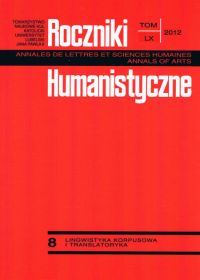About the Problems of Translating Film Titles from English into Polish
Abstract
The film – the product of popular culture, work of art and the mass medium – is nowadays one of the most intensively developing cultural fields. This article aims at presenting the basic grammatical, lexical, stylistic and semantic mechanisms used during the translation of the English film titles into the Polish ones and describing the functions of these language operations. The material analyzed, which covers the years 1990 – 2012, reveals certain changes that occur in the process of translation. Polish titles coming from the 90ies of the 20th century are – in comparison with the newer ones - more or less literal translations of the original titles. Recently there has been an upsurge of the numbers of more free translations. More syntactic and lexical modifications may be noticed. The number of colloquialisms is growing, as is the amount of expressive words and puns. The style of statements is also changing, quite often the elements of dramatization (monologue or dialogue) are appearing. These operations make a title look linguistically more attractive, intriguing, drawing attention; so it fulfills its basic advertising function.
La problématique de la traduction des titres de films anglophones en polonais
Le film – production de la culture populaire, œuvre d’art et également média – est actuellement l’un des domaines de la culture qui se développent le plus intensivement. Ledit article constitue une étude mettant en exergue les mécanismes principaux de la grammaire, du lexique, de la stylistique et de la sémantique employés lors de la traduction des titres de films anglophones en polonais ainsi que la détermination de la fonctionnalité desdits moyens langagiers. Le corpus d’étude couvre la période 1990-2012 et démontre certains changements pertinents dans le processus de la traduction. Les titres en version polonaise venant des années 90 du XXe siècle, sont – par rapport aux titres récents – une traduction littérale ou une traduction proche de l’orignal. Ultérieurement, il est à noter une croissance du nombre des traductions libres. Il convient de remarquer plus de modifications syntaxiques et lexicales. Le nombre de mots du langage courant, à caractère expressif et de jeux du langage augmente. Il y a des changements de style de parole et des éléments de la dramaturgie présents sous la forme du dialogue ou du monologue. Ces démarches font que le titre devient linguistiquement plus attractif (ce qui ne va pas toujours de pair avec la qualité du film), intriguant et attirant un spectateur, et satisfait alors à sa fonction primordiale – de publicité et de marketing.
References
Berezowski L., 2004, «Skąd się biorą polskie tytuły amerykańskich filmów?» [in:] Przekładając nieprzekładalne, Kubiński W., Kubińska O., Wolański T. [red.], Gdańsk, Wydawnictwo Uniwersytetu Gdańskiego, 313-323.
Garcarz M., 2007, Przekład slangu w filmie. Telewizyjne przekłady filmów amerykańskich na język polski, Kraków.
Jarewicz J., 2000, «Przekład tytułu: między egzotyką a adaptacją» [in:] Przekładając nieprzekładalne, Kubiński W., Kubińska O., Wolański T. [red.], Gdańsk, Wydawnictwo Uniwersytetu Gdańskiego, 477-481.
Kalisz R., 2009, «Tłumaczenia tytułów − praktyka i nadużycia» [in:] 50 lat polskiej translatoryki, Hejwowski K., Szczęsny A., Topczewska U. [red.], Warszawa, 531-537.
Perek M., 1997, «O dosłownictwie i rozpuście w tłumaczeniu tytułów» [in:] Między oryginałem a przekładem, t. 3, Filipowicz-Rudek M., Konieczna-Twardzikowa J., Kropiwiec U. [red.], Kraków, 231-238.
Copyright (c) 2012 Roczniki Humanistyczne

This work is licensed under a Creative Commons Attribution-NonCommercial-NoDerivatives 4.0 International License.





